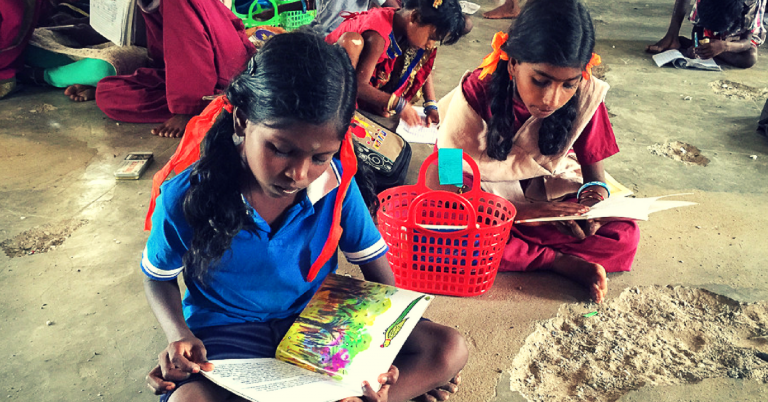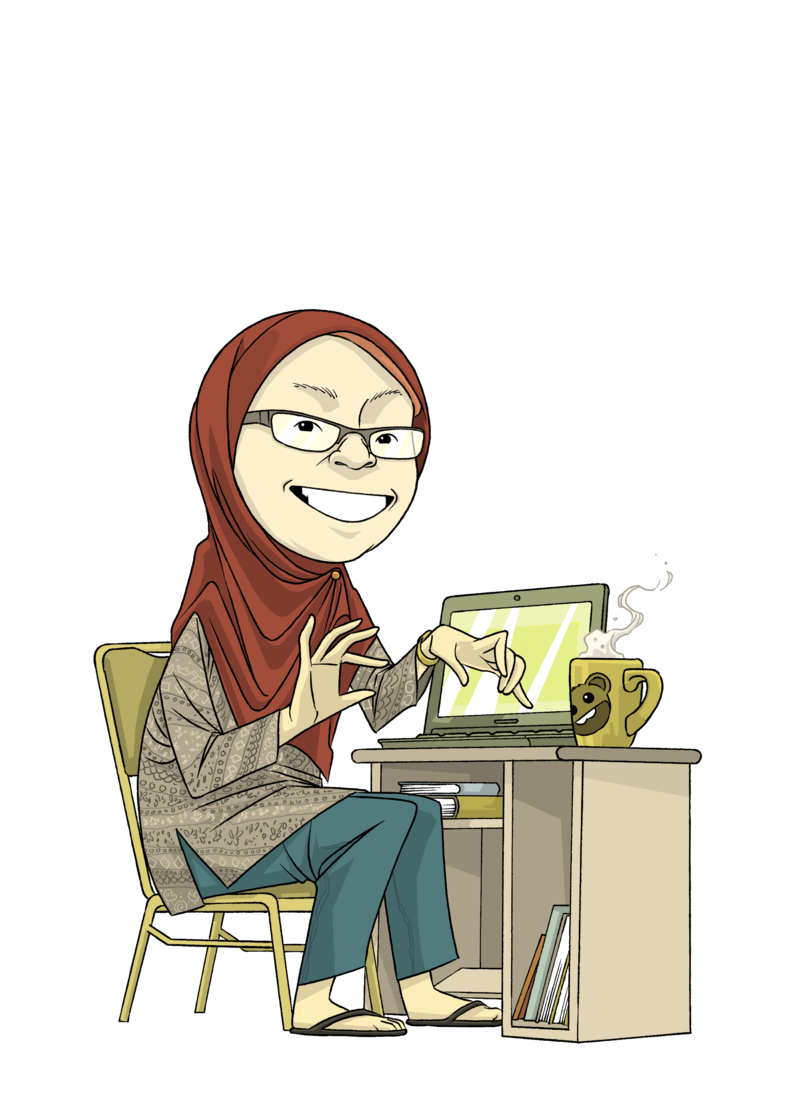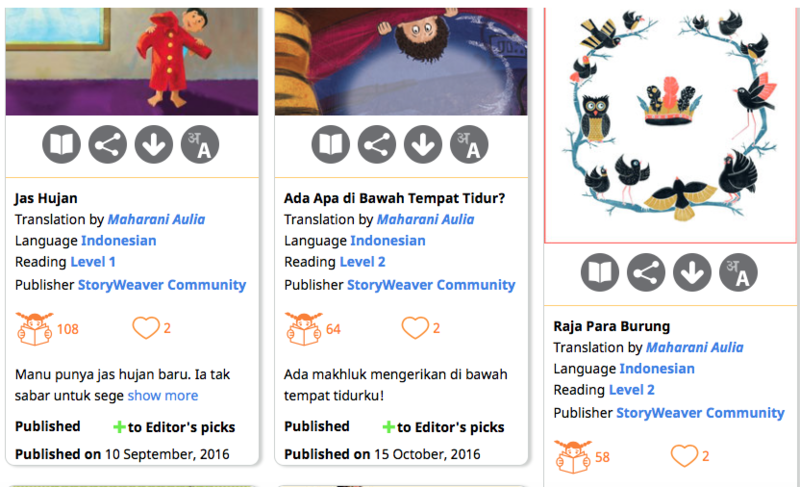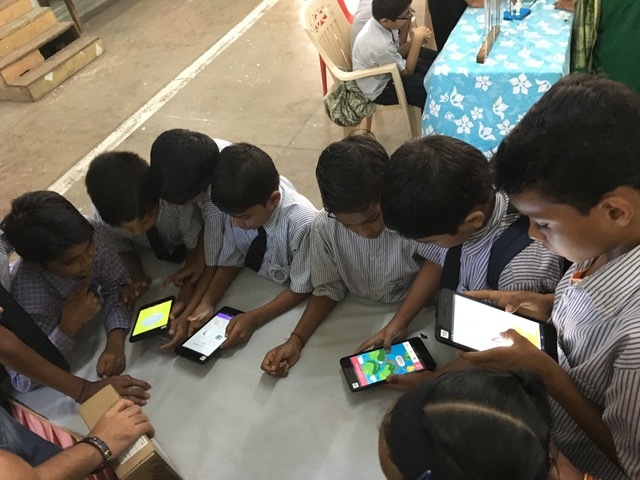Creating a Community of Super Readers
Posted by Remya Padmadas on June 20, 2017Communities Rising runs after-school programmes for children attending government primary schools in underserved rural villages in the Villupuram District of Tamil Nadu. The not-for-profit reaches out to over 1,600 students in ten villages in the area, with a focus on English, Tamil, math and computer education. In addition to this, they provide enrichment programmes in art, music and leadership skills. Two years ago, Communities Rising started a new reading programme for students. Betsy McCoy, founder and President of the not-for-profit, asked students “How many of you ever read books for pleasure?”
“Communities Rising was struggling to find affordably-priced, beginner reader books in English and Tamil that the children would enjoy reading,” shares Betsy.
This is a common problem faced by organisations working in education and literacy at the grassroots level: not enough books, in not enough languages, compounded by poor access and issues of affordability.
Most publishers cater to middle and upper income audiences in urban areas, often to the detriment of creating joyful books for underserved communities of children. StoryWeaver’s relationship with Communities Rising started earlier this year, when they attended a workshop and demonstration in Bangalore. Via the platform, Betsy and her team have access to a wealth of books in both English and Tamil, which they can download quickly and print to share with children. A choice of titles in a variety of genres, including books on STEM subjects, are available across reading levels to suit the needs of all students.
Communities Rising has downloaded 100 stories in English and Tamil, and is in the process of printing one set of all titles and distributing the same to each of its centres, thus reaching 360-400 students.
“We especially love the bilingual books printed in both Tamil and English that allow our students to read in both languages on the same page. These books are a tremendous help with comprehension – it’s like getting two books for the price of one!” says Betsy. “Plus, if a particular title is not available in Tamil, we can translate it on the platform and have it ready for the children to enjoy.”
Printing is often expensive and another roadblock so, Communities Rising experimented with a number of formats before narrowing down on one that worked best for them.
“We tried printing the books in two formats. One with single pages hole-punched and attached with rings, and the second with the pages stapled in the center. Durability is an issue so we printed samples on heavy, cardstock,” shares Betsy. The organisation believes that reading makes children learners for life, and encourages reading in a big way in their after-school programme. They have just opened their first community library in an area where there there are no other such spaces.

The organisation is running two other initiatives to great success. One is the ‘Daily 5,’ a reading programme developed by educators in the US; and the other is ‘CR Super Readers,’ a homegrown reading incentive programme. Both programmes are working wonders! Students are first taught how to pick ‘Good Fit Books’ that they can read comfortably. The books are then kept in a book basket which they share with a friend.
Each day the students have to read to themselves for 5 to 10 minutes. Other days they have to read to their partner. In this way they can help and learn from each other.
Students keep a list of all the books they read and have it checked by a teacher for comprehension. This forms the basis of the ‘Super Reader’ program.
“In addition to the book basket which contains books, we also give the children a ‘reading necklace.’ They get a bead for each book that their teacher certifies they have actually read. After reading 10 books, they get ‘Readers Are Leaders’ pencils, and after 20 books, they get pins that proclaim them ‘CR Super Readers’.”
“I’m happy to say that we are giving out many pencils,” says Betsy, who believes that the necklaces, reading pencils and Super Reader pins help build a sense of community and sense of belonging to Communities Rising, amongst the children.
“At the end of the year, the top readers from each center will travel to Chennai to visit Tara Books for a program there and the top reading center will have a book party!” she says. “All of our students are now reading everyday; story books, non-fiction books, biographies, all kinds of books. They are discovering the joy of reading! Without StoryWeaver, this remarkable change in our students’ reading habits would not have been possible,” shares Betsy.
“Last year, I told some of our kids, that I was looking forward to hearing complaints from their parents that they were spending too much time reading, instead of playing or helping at home. We aren’t quite there yet, but with access to so many stories now, I have no doubt those complaints aren’t far away,” says Betsy.
We look forward to hearing those complaints too!
Be the first to comment.Meet Maharani Aulia
Posted by Remya Padmadas on June 12, 2017
Maharani Aulia, commonly called by her nickname Lia. She has written dozens of stories and translated over a hundred titles from English to Indonesian. Her works are spread in local and national media, and published as books in several national publishers. She writes for the StoryWeaver blog about her writing journey. (Caricature of Maharani Aulia by Diyan Bijac.)
I have been writing since I was a kid. My first very-short story was published in a local newspaper, Surabaya Post, when I was 11. This encouraged me to continue my writing, although I couldn’t write much because I was still in junior high school. I wrote only 2 stories at that time, published in local children’s magazine, Mentari (Mentari means the sun in English). I love to read since childhood because my parents gave me many books. While in high school and college, I just wrote for my school magazine and journal for our own circle.
I started writing as a professional writer in 2005, with my first children's book published by a national publisher (Mizan), entitled Makan Sepuasnya. (Eat As Much; on the contrary, I wrote this story to inspire my readers to share our food with the poor.)
In fact, my parents did not really support me to become a writer. Perhaps they thought as a writer, I could not be rich. My educational background is animal health (part of veterinary medicine), but I keep writing for children because this is what I love since I was a kid. I write for early readers and older ones, and recently wrote about a child in a kindergarten who can not read yet, but he can draw. I’m still learning to write good children stories.
I recently wrote two biographies, in Genius Kids series, at the publisher’s request. Writing biographies gave me a new experience, but I prefer to write stories and non-fiction articles on topics I choose. I have published six articles in national papers (Kompas, children section) about how to learn effectively, how to care about our senses, about plastics and its negative impacts on environment, how to live healthy with animals, why we should wash our hands with soap, and introduction to cashless society. All these are for older readers (10-12 years old).
Bitten by the translation bug
I have a passive knowledge of English, and I’m still practicing speaking it fluently. Basically I like to learn about languages, and I have translated stories and articles on my own since I was in high school. About a decade later, a publisher offered me to translate storybooks from English into Indonesian, and I was so excited. I have translated over a hundred books, some of them are teenage books. Reading so many stories on StoryWeaver give me much information and entertainment. I like to translate Indian stories written in English into my language, and I like to share my translations with my friends and colleagues. They like StoryWeaver’s stories, too. Some of them have contributed their original stories to the web.

My friends have a free download e-book website, called SeruSetiapSaat (it means Fun Anytime in English). I am now waiting for my first picture book to be published on it, and after being illustrated, I plan to link it to StoryWeaver. Of course, I will translate it into English to be read by everyone:).
Maharani Aulia has translated 25 stories to Indonesian on StoryWeaver. You can read them here.
comments (3)mGuru: A K-5 learning app for India’s under-served students
Posted by Remya Padmadas on June 20, 2017From Archimedes to Newton, from inventors to entrepreneurs, that fleeting flash of inspiration is what generates great ideas,makes humans progress, keeps the world moving forward. For Adam Korakhiwala, his ‘a-ha’ moment came in the form of a grim statistic in the 2014 Annual Status of Education (ASER) report.
ONLY 1 in 4 Std. 5 students can only read basic English sentences.
At the time, Adam was a student of Public Policy with a minor in Computer Science at Stanford University. “I read the report as a Public Policy student, but when I started thinking about how I could be a part of the solution to a problem like this, my background in Computer Science kicked in” shares Adam, founder of mGuru, a Mumbai-based edtech startup, aimed at the K-12 sector of students in urban, peri-urban and rural India.
|
I remember thinking how affordable smartphones were becoming and reaching so many households and people in India, and that very soon, all families would have the world’s collective knowledge in their pockets. That thought was the starting point for the idea that is now mGuru.” |
A fundamental desire to bring great educational technology to any child, anywhere.
Armed with his degree, Adam returned to India with the idea to use mobile technology to help improve literacy and numeracy skills of children. “The first thing I did was to spend time in classrooms as a silent observer to study teacher interactions and student responses. I wanted to understand how different stakeholders in schools felt about education, so I extensively interviewed students, teachers and parents and NGO leaders to get as holistic a view as possible.”
After spending months at the Educo-run BMC Sai Baba Path School, Mumbai and classrooms in Akanksha and Teach for India schools, Adam’s seed of an idea began to germinate. He put together a team using ‘hustle and passion’ by posting on LinkedIn and techie job boards.
mGuru: Helping put learning in the child’s hands
mGuru is a mobile learning app for K-5 students, focusing on English and Math. The apps provide an interactive learning journey for children, with the explicit aim of accelerating learning outcomes in an engaging way. The vision of mGuru is to package the best learning practices and research into a platform for the masses, so that any child can have the tools to gain basic literacy and numeracy skills. “We aim to significantly increase learning outcomes at scale, and we hope to build a platform that delivers that.” avers Adam.

While smartphone penetration is on the upswing across India, the mGuru team is cognisant of other infrastructural issues related to internet connectivity that much of the country still faces.
“The apps function largely without internet and are designed to work as well on low-end smartphones as they do on high-end devices.”
Once the initial prototype of the application was ready the team tested it with 100 3rd and 4th standard public school students, in Mumbai. “Our team would go in every week to see how children were reacting to the app, what they liked, what they ignored… and then every week we would go back and incorporate those learnings into the app” remembers Adam. After multiple rounds of tinkering, and a complete redesign to be more “pedagogically sound and engaging for kids” the mGuru app was officially released in August, 2016.
Learn while you play
mGuru’s English app is particularly successful with children as it gamifies the learning process. Within mGuru English, there is a reward system in the form of mangoes. By completing various activities, Manu the monkey collects mangoes which the child can then use as currency to purchase stories to read available on the app. All these stories are from StoryWeaver, an online digital repository of multilingual children’s stories from Pratham Books.
“I first read about StoryWeaver when the platform was launched. At the time, we were looking for stories to include in the English app that were fun and engaging for children to read, along with being culturally relevant to them. StoryWeaver offers all this, and the biggest bonus is that since the stories are openly licensed and in open formats, we can use them for free, and in different ways on the app with subtitles and audio elements that we have built in-house.”
The stories have been immensely popular with the students, as TFI fellow Vishal DB noticed:
“The app keeps students across all reading levels, engaged. A combination of the app being child friendly, the interesting content and the novelty of the tabs ensure that the students are hooked.”
While the stories on the apps are in English, it also has a button, which the child can touch for the story to be translated to another language they are more fluent in. Currently, mGuru English teaches English via Bengali, Gujarati, Marathi, and Hindi. However, they plan to expand this to integrate more major Indian languages such as Tamil, Kannada, Malayalam, and Urdu. The stories offered are regularly updated so that children always have something new to read and enjoy.
“The stories from StoryWeaver have already been read 45,000 times who have done over 185,000 activities!” Adam shares enthusiastically.
mGuru at the PTA
mGuru has partnered with NGOs such as Teach for India, Akanksha, and Yuva Unstoppable and is currently used by 17,000 students all over India, and contains 185,000 activities. Impact is measured by looking at various statistics such as the time spent on the app, how often students return to the app, the number of stories read, and improvements in the scores of students.
“During our research phase, we learned that almost all the students in the schools we visited went for some form of ‘tutions’ after school, which showed that parents were invested in improving their child’s learning. If parents were willing to pay anywhere between Rs.300-600 for tuition, then we felt they might be willing to pay an affordable Rs. 30 per month for our app. We reach out to parents to tell them about and help download the app at school PTAs. So far we have had a very positive response from them.” shares Adam. A sentiment echoed by this parent at Sai Baba Path Public School, Mumbai.
“सर पिछले दो दिन से मेरे दोनो बच्चे ऐप को छोड ही नही रहे है । बाकी गेम खेलना तो उन्होनें बन्द ही कर दिया है बडी बात ये है के वे हमारे बिना ही सब इस्तेमाल करना सीख गये है. हम से ज्यादा मोबाइल के बारे मे उन्हें पता है।”
mGuru is also experimenting with other novel ways getting their app into the hands of more children. Starting next month, they are tying up with a chain of bakeries in Kolkata, where each bakery will also be an mGuru distribution centre. “Every time someone shops at the bakery,they'll get an offer of three weeks free access to mGuru English app. We’ll have someone there to help them download the app and do a demo if needed. If this pilot works, we will look at ways to replicate this in other geographies.” Adam reports.
Setting their sights high
The team is excited about future plans which include adding a math component to the app, adding more languages and more diverse content in the form of videos and diverse activities.
“Everyone on the team has a fundamental passion and desire to bring great educational technology to any child, anywhere.” shares Adam.
Be the first to comment.